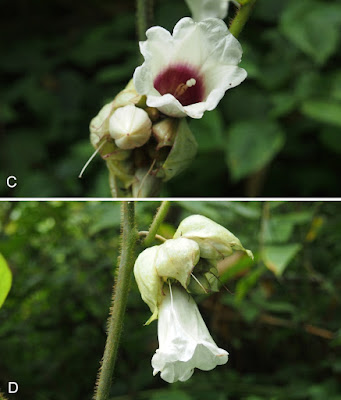 |
| Argyreia decemloba
Traiperm, Fujikawa & Staples
in Traiperm, Fujikawa, Chitchak, et al., 2019.
DOI: 10.3372/wi.49.49108
|
Abstract
Argyreia decemloba Traiperm, Fujikawa & Staples, a new species of Convolvulaceae from Natma Taung National Park, Chin State, Myanmar, is described here with detailed illustrations and summaries for its distribution, ecology and IUCN conservation status. This new species is a high-climbing twiner that can be distinguished by a white or pale yellow corolla with a deep red or purple-black colour inside at the base of the tube, a ten-lobed corolla limb, and staminal filament bases expanded and densely covered by hispid hairs. Argyreia decemloba is here assessed as Near Threatened (NT) following IUCN Red List categories.
KEYWORDS: Argyreia, Chin State, Convolvulaceae, filament morphology, Mount Victoria, Myanmar, Natma Taung, new species discovery, SE Asian biodiversity, staminal trichomes, taxonomy
Argyreia decemloba Traiperm, Fujikawa & Staples, sp. nov.
Holotype: Myanmar, Chin State, Mindat Township, ...
Diagnosis — Three species of Argyreia are known to have a white or pale yellow corolla with a deep red or purple-black colour inside at the base of the tube as well as a 10-lobed limb: A. barbata (Wall.) Raizada; A. maymyensis (Lace) Raizada; and A. decemloba (Table 1). Argyreia barbata and A. maymyensis have quite narrow, linear inflorescence- and floral bracts that do not cover up the calyx and corolla base; the hispid-hirsute indumentum of A. barbata, composed of dense, bristly hairs may obscure the floral organs underneath. In contrast, A. decemloba has broad, laminar inflorescence- and floral bracts that cover the floral organs underneath; the abaxial surface of the bracts has a completely different, dimorphic indumentum composed of two different trichome types (Table 1).
....
Distribution and ecology — So far known only from Chin State, Myanmar, occurring at elevations of (740–)1025–1200(–1530) m. A high-climbing twiner in trees and shrubs inhabiting open, sunny places such as roadsides, footpaths in secondary forest, edges of deciduous forest, clearings in evergreen forest, and in semi-evergreen forest; preferring moist soils along streams or the banks of rivers. The soil type has not been reported.
Etymology — The specific epithet recognizes the distinctive 10-lobed corolla limb.
Paweena Traiperm, Kazumi Fujikawa, Natthaphong Chitchak, Prachaya Srisanga, Charun Maknoi and George Staples. 2019. A New Species of Argyreia (Convolvulaceae) from Myanmar. Willdenowia. 49(1); 65–70. DOI: 10.3372/wi.49.49108





